Most of what follows applies to the Tudor times in England. When I researched the 16th century for what society was like, punishments for crimes, clothing, medicine and education mostly all I could find was either about Tudor England or it didn’t apply to this century, but the 18th, a bit far ahead. I don’t know why this is, as the rest of the world existed, even Christopher Columbus had been to America by this time and so why not have more about the other areas of the world besides just Tudor England? I can only guess that much of 16th century Europe had much of the same things going on in their way of living as England did. However, if someone could point me to more information on other countries at this time that would be wonderful and I would love to share it with everyone else. So, now that I’ve explained why much of this is about Tudor England let’s get on with it.
Society in 16th Century
The large majority of the population in England had lived in small villages and had made their living from farming. Towns would grow larger and more important than they had been in previous centuries, and trade grew rapidly. England would become more and more of a commercial country through the century as mining of coal, tin and lead flourished. The iron industry also flourished. Due to the growing economy, the English became richer and richer through this time as well.
As England was growing to be a more prosperous country, those that were well off, mainly those in the upper class, but also the middle class, benefited from the growing wealth of the country. For the poor though life hadn’t improved much from the previous century, life was still hard and rough.
The population of England may have been around two and a half million in the 15th century, but steadily rose throughout the 16th century. By 1525, the English population rose to around three million and by 1600 it rose by a million more.
The Tudor society was divided into four broad groups. At the top of society was the nobility, who had owned huge amounts of land. Just below the nobility were the gentry and rich merchants. Gentlemen owned large amounts of land and were usually educated. They also had a family coat of arms and the most important of gentlemen never had to work. Below these second class citizens were the yeomen and craftsmen. Yeomen also owned their own land and could have been as wealthy as a gentlemen. The difference between yeomen and gentlemen was that yeomen had to work and often did so alongside their men. Both yeomen and craftsmen were taught to read and write. The lowest class of society was tenant farmers. They would lease their land from the rich and were wage laborers, they also were often illiterate and very poor.
During the 16th century, parishes became the basis of the local government. The most important person in a parish was an appointed magistrate called the Justice of the Peace. However, in Tudor times, kings and queens grew to be even stronger than they were in the past. During the middle ages barons had held castles that were difficult to capture, so it was easy for them to rebel. During this century cannons changed all of this.
Jobs were not easy to find in Tudor times. There were thousands of people that were out of work, who wandered around looking for jobs. There were also disabled beggars, and those who pretended to be mad (mentally ill) or disabled in order to be allowed to beg. Tudor governments would tolerate disabled beggars, but they didn’t tolerate able-bodied people having no job, wandering from place to place. They had thought that such ‘sturdy vagabonds’ without a fixed place in society were a threat to law and order.
Since the 14th century, there were laws in place against vagabonds, but in 1530 a new law was passed. The old, disabled poor were given licenses to beg. However, anyone that was roaming around without a job was tied to a cart in the nearest market town and whipped until they were bloody. These people were then forced to return to the parish that they were born in or where they had lived for the last two years. A law in 1547 stated that vagabonds could be put into slavery for two years. This terrible law was “quickly” abolished in 1550 and flogging was once again made a punishment for vagrancy.
16th Century Punishment
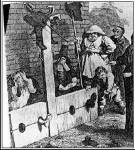
Example of the stocks
During the Tudor times, prison was seldom used as a punishment. Instead people would be held in prison until their trial and punishments were simple but harsh, such as flogging. Minor crimes were also punished by the pillory or the stocks. The pillory was a wooden frame on a pole, with holes through which one’s head and hands were placed through, then the frame was locked. The stocks were a wooden frame with holes of which one’s feet were put through and then locked. For more serious crimes one could be put to death. Beheading was reserved for the wealthy, and most ordinary people were hanged.
Towns in Tudor England
Only a small part of the Tudor population actually lived in towns. Peasants would bring things to weekly markets to sell. These would include all sorts of manufactured goods such as shoes and pottery.
At the start of the century, London probably had a population of 60,000-70,000. By 1600, The city’s population had been over 250,000. Other Tudor towns were smaller. For example, in 1500 Bristol probably had a population of about 14,000 by the end of the century the population grew to 20,000. Norwich, the next largest town had a population of 10,000 at the start of the century and by 1600 it still had a population of less than 20,000. York was the largest town in the north of England, with a population of about 10,000 in 1500 and it had only risen to about 12,000 by 1600. Exeter only had a population of about 9,000 in 1600. Most towns at this time were much smaller, with populations between 2,500 and 4,000. Any place was considered to be a town if it had more than 1,000 inhabitants.
Most Tudor towns had tradesmen of one kind, who would live and work on the same street. For instance, in many towns, butchers and slaughterhouses gathered together in a street called the Shambles.
Towns were quite dirty, smelly and crowded. There were no sewers and no drains during this time and rubbish, such as rotting vegetables, offal and dirty water were just thrown in the streets. In some towns, every man was to clean the street in front of his house once a week, but it’s pretty unlikely that many people even bothered. Rats and other vermin were really common.
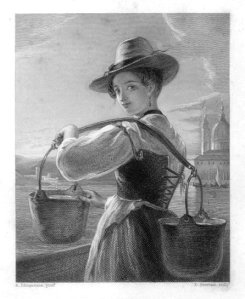
Example of a water carrier, but in Italy
People usually got their water from wells or from water carriers, they’d carry water in containers on their shoulders. Some towns did have conduits that would bring in water from the countryside, which the public could use. Furthermore, in some towns the main streets were actually paved, but most town streets were not. Streets were also very narrow. Upper stories of buildings would jut out over lower stories, these were called jetties. At night, streets were dark and dangerous. Apart from the danger of being robbed, it was easy to also have an accident in the dark, unpaved streets. In London, you could hire a link boy, who would have a lamp with him to light your way to your destination. However, many people would simply avoid going out after dark.
The majority of roads during this time were just dirt trails. Men were supposed to, by law, spend a number of days repairing their local roads, but it’s unlikely that they did much good. People had traveled by horse and you could either ride your own or could hire a horse to take you where you wanted to go. From the mid-century, some rich rode in carriages, which must have been very uncomfortable as they didn’t have springs and roads were very bumpy.
Due to road conditions, and the means of transportation, one would be lucky if they could travel 30-38 miles (50-60 km) a day. Normally it would take a week to travel from London to Plymouth, today it would only take about 4 ½ hours to drive this distance (236.5 miles) (380.6 km). Rich people did tend to deliberately travel slowly, as they had felt that it was undignified to hurry.
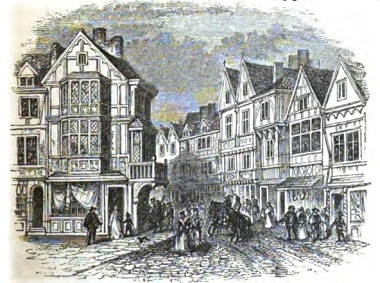
16th Century Elizabethan Town
At times, goods were transported by pack horse. Some carriers would use covered wagons to carry their goods and sometimes passengers. However, when possible, people preferred to transport their goods by water. All around England there was a ‘coastal trade’.
Given the dirty conditions of Tudor towns, it’s not surprising that outbreaks of plague and other illnesses were common. When the plague struck the country, it may kill ten to fifteen percent or even more of the population of one town, but towns always recovered. There were always plenty of poor out in the countryside that were willing to come to towns in search of work, thus repopulating the areas that lost so many.
London in the 16th Century
London would grow enormously during the 16th Century. In 1500, the town was surrounded by walls, protecting the area from attacks. By 1600, rich men had built houses along the Strand, joining London and Westminster. In the Middle Ages, the church had owned about a quarter of the land in London, but when Henry VIII had dissolved many monasteries, it released a great deal of land for new buildings.
Along the walls of London were several gates: Aldgate, Bishopsgate, Moorsgate, Cripplegate, Aldersgate, Newgate, which was used as a prison, and Ludgate, also used as a prison. Body parts of traitors who had been hung, drawn and quartered were displayed over these gates as a warning.
Stretching across the River Thames was London Bridge. It had buildings along its length as well and many of them had shops on their ground floor. South of the Thames was the large suburb of Southwark. The Thames River was a major transport route, as London was the largest port in England. Sailing ships came to quays just before London Bridge, and smaller boats, owned by water-men for transporting people also used the Thames as a route. Tudor monarchs and other rich people had their own barges. There were also fishermen in London, making their living from the fish of the Thames, which consisted of salmon, trout, perch, flounder and beam. However, the river sometimes would freeze over and fairs were held on it.
At night the streets of London were dark and quite dangerous. By 9pm in the summer and at dusk in the winter, church bells would ring, alerting that curfew had started and the city gates were locked.
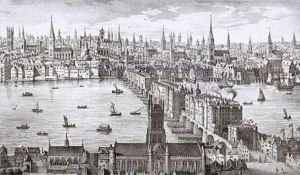
16th Century London Bridge over the River Thames
Homes in Tudor England
During the Middle Ages well-to-do people lived in homes designed for defense instead of comfort. During the 16th century, life was safer, therefore, homes no longer had to be easy to defend. Those that were rich would build grand houses, for example: Cardinal Wolsey built Hampton Court Palace and the Countess of Shrewbury built Hardwick Hall in Derbyshire.
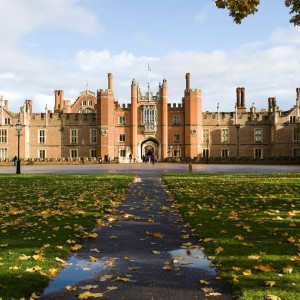
Hampton Court Palace
Middle class people built sturdy ‘half-timbered’ houses that were made of a timber frame, filled in with wattle and daub; wickerwork and plaster. Later in the century, people would build or rebuild their homes with a wooden frame that was filled in with bricks. The roof of the house was usually thatched, though some well off people had tiles. In the city of London, all houses would have tile roofs, due to the fear of fire.
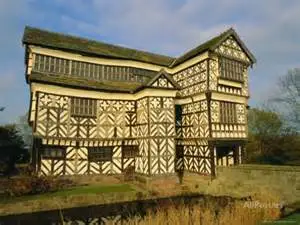
16th Century House in England
In Tudor times, furniture was more plentiful than it had been in previous times, but it remained to be built pretty basic. In wealthy homes, furniture was usually made of oak and was massive and heavy. The furniture in this time period was expected to last for generations, one would expect to pass down the furniture to their children or even grandchildren. Comfortable beds would also become more and more common. In the middle class Tudor home a mattress was often stuffed with flock, a kind of rough wool. Chairs were also more common than they had been in previous times, but they were still expensive, even in an upper class home children and servants would sit on stools. The poor had to make do with sitting on stools or benches.
During the 15th century, only a small minority of people could afford glass windows, but by the 16th century they became much more common, yet still remained expensive. If a family had moved to another home they would take their glass windows with them. Windows were made of small pieces of glass that were held together by strips of lead, this style of windows was known as lattice. Poor people still had to make their windows out of strips of linen that were soaked in linseed oil.
Chimneys were also considered a luxury, though they had also become more common. Furthermore, in the Middle Ages, wealthy homes were dominated by the great hall, which would extend all the way up to the roof of the building. In the 16th century many people had installed another story on their home, over the great hall. Therefore, wealthy Tudor homes became divided and had more rooms. The rich homes also had walls that were lined with an oak paneling to keep out drafts. People would sleep in four-poster beds that were hung with curtains to reduce drafts as well. They also hung tapestries or painted cloths on their walls to do the same.
Carpets were a luxury during this century as well and only the rich could manage to afford them. Due to their high “price tag” they would be hung on the wall or over tables instead of on the floor, as we use them today. People would cover their floors with rushes or reeds, which they had poured sweet smelling herbs over.
Wealthy people would light their homes with beeswax candles, but these were expensive as well. People of other classes made used candles from tallow (animal fat), they would give off a quite unpleasant smell and the poor made do with rush lights, which were rushes dipped in animal fat.
I was surprised to learn that the Tudors, well at least the rich ones, had clocks in their homes. Most people though relied on pocket sundials to know what time it was. The rich were also fond of gardens, many of these people had mazes, fountains, and hedges cut into shapes (topiary). Those that were less well-off used their gardens to grow vegetables and herbs in.
The poor people during the 16th century would live in small huts, which had one or two rooms, at times three. Floors were simply the hard earth and furniture was very basic. They had benches, stools, a table and wooden chests. People of this class of society slept on mattresses stuffed with straw or thistledown and the

Woolly Mullein Plant
mattress was placed on ropes that were strung across a wooden frame.
In 1596, Sir John Harrington would invent a flushing lavatory with a cistern, but the idea failed to catch on. Why would people NOT want such a grand device? Lol. People continued to use chamber pots or cess pits, which were cleaned by men known as gong farmers. A toilet during this time was called a jake. To wipe with (toilet paper), the rich would use rags, but the poor, at times, used a plant called a woolly mullein. This does not sound like a very good experience.
Food in the 16th Century
During this century, the rich would enjoy eating vast amounts of meat, but they ate few vegetables. On certain days, by law, people had to eat fish instead of meat. At first this was for religious purposes, but later in the century it was done to support the fishing industry. If one lived near a sea or a river you could eat fish like herring or mackerel, otherwise you may have to rely on dried or salted fish, due to the lack of refrigeration units they had to be preserved in this manner.
The poor lived on a pretty dreary diet. In the morning they would eat bread, cheese and onions and they would only have one cooked meal a day, usually mixed grain with water, with added vegetables, and if they could afford it, strips of meat. All classes would eat bread but the quality of it varied. The rich would enjoy bread made from fine white flour, the poor ate coarse bread of barley or rye.
People had also been fond of sweet foods, again if they could afford them, as sugar was very expensive. Most people would have to use honey to sweeten their food with. New foods were introduced from the Americas as well. Turkeys were introduced into England in 1525 and potatoes were brought to England in the 1580s, however only few English people ate them. Normally people wouldn’t drink water because it was too dirty. Young children drank milk and other people would drink ale or beer. If a person was rich they would drink wine, but most drank cider and perry.
The rich enjoyed showing off their gold and silver plate. Middle classes would have dishes and bowls that were made of pewter and the poor made do with wooden plates and bowls. Therefore, if you had a fancy plate people would know you were rich. There were also no forks and people generally ate with knives and their fingers, or sometimes a spoon. Rich people had fancier silverware, spoons made of silver or pewter. The poor would use the basic wooden spoon.
Ordinary people made their own foods. A farmer’s wife would cure bacon and salted meat so as to preserve it. She also baked bread and brewed beer and made pickles and conserves and preserved vegetables as well. Many farmers kept bees so they had access to honey.
Games of the 16th Century
Even though the days of armored knights were over, rich people still enjoyed participating in tournaments. Contestants would dress in armor and ride horses, fighting with wooden lances and swords. The rich also enjoyed hunting. They would use bows and arrows to hunt deer, and after the animal was killed it was eaten. They also went hawking, falcons were trained to kill other birds and were used to participate in this form of hunting.
The rich also enjoyed wrestling and ‘casting the bar’, which was like shot-putting but with an iron bar. They also played billiards and enjoyed board games such as chess and backgammon. A backgammon set has been found on the wreck of the Mary Rose from this time period and was the same as the ones that are still used today. They also enjoyed playing tennis, however, it was played with a leather ball stuffed with hair, unlike those used today. They also participated in the games of bowls and skittles and playing cards, which was also quite popular.
All classes of society enjoyed gambling. The poor would use dice to gamble and also played games like shuffleboard (shove ha’penny) and nine men’s morris. The Tudor people also played drafts and fox and geese.
People of all classes also enjoyed music and dancing, which was very popular at this time. The printing press was around by this time and had made books much cheaper, therefore, reading was a popular pastime for those of the upper classes. Ordinary people played a rough version of football (soccer in America). There were no rules at the time for the game and the pitch was often a large area, including woods and even streams. The game was very rough back then, causing injuries like broken limbs were a common occurrence. Cruel ‘sports’ like cockfighting were also popular, as was bear baiting. A bear would be chained to a post and dogs were trained to attack it. I do not think that most children, and probably even most adults today would have enjoyed most of these games.
The Theatre
People in the 16th century were able to take in a play once in a while. They enjoyed both comedies and tragedies. Groups of professional actors had become common, but the Tudor governments were suspicious of actors. They were regarded as layabouts who did no useful work. From 1572, actors had to have a license from a noble to participate in the theatre. Without this protection, actors were likely to be arrested as vagrants.
In the early part of the century, they would perform in market squares or inn courtyards. Late in the century, plays had become more and more popular and eventually it had become worthwhile to build theaters in large towns. In 1576, a man by the name of James Burbage would build the first theatre and others would follow. Those who could afford the best seats were sheltered from weather, but poor customers stood in the open air and were known as groundlings. The rich had seats on the stage.
During this time there were no female actors, boys would play women’s parts. Plays were also held during the daytime since lighting a stage was difficult.
Education
During the 16th century, boys would usually go to nursery school, known as a ‘petty school’ at the start of their education. They then moved on to grammar school when they were about seven years old. The school day started at six in the morning during the summer, seven in the morning in winter. People went to bed earlier and would wake up earlier as well, than what they do now. Lunch was from eleven in the morning to one in the afternoon. School would finish at about five in the afternoon. Boys would attend school six days a week and there were few holidays.
Many Tudor children would learn how to read and write with something known as a hornbook. This was actually not a book in the modern sense, but a wooden board with a handle, fixed to the board was a sheet of paper with the alphabet and Lord’s Prayer written on it. The paper was usually protected by a thin slice of animal horn.
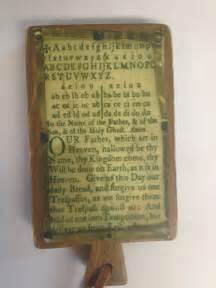
Hornbook
Discipline at this time in school was quite harsh. Teacher would often have a stick with birch twigs that were attached to it for hitting the children with when they misbehaved.
When children were about fifteen or sixteen years of age, the brightest boys may go to one of England’s two universities at the time; Oxford or Cambridge. Many boys though didn’t go to school at all. If they were lucky they might attend a seven-year apprenticeship and learn a trade. Some craftsmen could read and write but few laborers could.
In a rich family, girls were taught by a tutor at home. In the middle class, their mother might have taught them. Both upper and middle class girls were educated, lower class girls were not. Children who didn’t go to school were expected to work. They would help their parents at home by doing tasks, such as scaring birds when seeds were sown, weaving wool and other household chores. Children from well off families usually had their marriage arranged for them. Those from poor families had more of a choice of who they wanted to marry. However, girls of any class usually married young, many by the time they were fifteen or sixteen years old. Boys often married a few years older, between the ages of eighteen and twenty-one years old.
16th Century Clothing
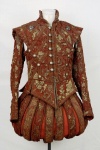
Example of men’s clothing with embroidery
For the rich, fashion was quite important. For the poor though clothing had to be tough and practical. All classes would wear wool clothing, however, it varied in its quality. The rich would wear fine quality wool, whereas the poor would wear a coarse type of wool.
Linen was used to make shirts, and only the rich could afford cotton and silk. They would embroider their clothing with silk and gold or silver thread. The rich women would wear silk stockings as well. Men wore short trouser-like garments, known as breeches. They had also wore tight fitting jackets that were known as doublets. Another jacket that was worn over the doublet was known as the jerkin. Over the jerkin, rich men would also wear a gown until later in the century when they wore a cloak or a cape. Working men would wear a loose tunic instead of a doublet, which was easier to work in. Some workingmen wore a leather jerkin that was known as a buff-jerkin. Men had also wore stockings or woolen socks, which were called hose.
Women would wear a kind of petticoat called a smock, shift or chemise. It was made out of linen or wool and
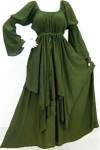
Peasant Dress
a wool dress was worn over it. The dress was made out of two parts. A bodice or a corset like garment was one piece and the second was a skirt. Sleeves were held on with laces and were able to be detached. Workingwomen had also worn a linen apron. In Elizabethan England many women had wore a frame made out of whale bones or wood underneath their dress. This was known as a farthing. If a woman couldn’t afford a farthing, they wore a padded role around their waist, this was known as a bum roll. Tudor women didn’t wear knickers, but at times men would wear linen shorts.
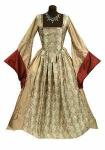
Anne Boleyn Dress
Everyone at this time wore hats. The poor women had often wore a linen cap called a coif. After 1572, by law, all men except nobles were required to wear a woolen cap on Sundays. Buttons were usually used for decoration. Clothing was often held together with laces or pins instead. Furs were also worn, they were made out of cat, rabbit, beaver, bear, badger or polecats. People used mostly vegetables for dyeing their clothing. Vegetables used for madder for red, woad for blue or walnut for brown coloring. The most expensive dyes were bright red, purple or indigo. The poor had often wore brown, yellow or blue colors. Some Tudor women also wore wigs. Both Queen Elizabeth and Mary Queen of Scots were known to have worn them. When Mary was beheaded her wig actually came off.
There were sumptuary laws that would lay out what each class of society could and couldn’t wear. These complicated laws said that only those with a certain amount of wealth could wear certain expensive materials, such as velvet and silk. The laws, of course, had made no difference to the poor, as they couldn’t even afford costly materials anyhow. However, the laws were supposed to keep the classes separate. Each person was supposed to be able to tell which class another person had belonged to by his/her clothing, though many simply ignored the sumptuary laws.
Medicine of the 16th Century
During the 16th century, many people died from epidemics such as the sweating sickness and possibly influenza. Many other people would die from smallpox, even Queen Elizabeth I almost died from the illness. Even if you had survived smallpox it could leave you disfigured with pox marks or even blind. Syphilis was also rampant and dysentery was also a major killer. Many women however died in childbirth.
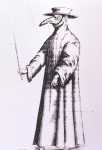
16th Century Plague Doctor
Doctors during this time were very expensive. They could do little about illnesses, partly because they didn’t know what was causing the diseases. Doctors also had little idea of how the human body worked. They thought that the body was made of four fluids, or humors. These humors consisted of blood, phlegm, choler or yellow bile, and melancholy or black bile. In a healthy person all four of the humors were balanced, but if one had too much of one of the humors the person would fall ill. If a person had too much blood they would be bled either with leeches or by cutting a vein. Too much of the other humors would be treated either by eating the right diet or by purging. Purging was done by taking medicines to cause vomiting. The doctors of the time also thought that infectious disease, like the plague, was caused by poisonous ‘vapors’ that were drifting through the air, and these vapors were absorbed through the skin.
One of the main ways of diagnosing a sickness was through a uroscopy, examining urine. A doctor would diagnose a person by their urine’s appearance, smell and even by taste. Astrology had also played a part in medicine. Most doctors believed that different zodiac signs ruled different parts of the body. Since doctors were so expensive, many people went to wise women if they were ill. Wise women would have the knowledge of different herbs and their properties and may be able to help an ill person.
The average lifespan was shorter than it is today. At birth a person was thought to have thirty-five years to live, only half of all people born would actually live to thirty-five. However, many people died while they were still children. Out of all people born between 1/3 and ½ would die before the age of sixteen. If they did survive to their mid-teens, one could probably live to their fifties or early sixties. Even in the 16th century there were some people that made it to their seventies or eighties.
Weaponry of the 16th Century
During this century, warfare was transformed by guns. Early guns were lit by a slow match, a string would be soaked in saltpeter and when it was lit it would smolder. The slow match was touched to gunpowder to ignite it. By mid-century the wheelock was invented. A metal wheel would spin against a piece of iron pyrites that would generate a spark that ignited the gunpowder. As a result of these inventions, most cavalry stopped using lances and instead carried two or three pistols each that were ready to fire. They would also carry a saber.
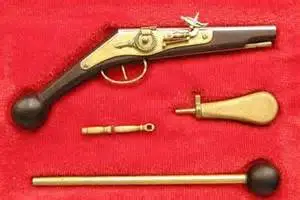
16th Century Pistol
Early on in the 16th century, the traditional English weapon was the longbow. When handguns were increasingly used, the longbow slowly went out of use during the Tudor times. Muskets however, took a long time to reload and during this time the infantry needed protection from the cavalry. They were protected by men with pikes, a weapon like a long spear.
Tudor forts and walled towns often had bastions, triangular sections of wall that jutted out from the rest of the wall. These provided flanking fire, in other words guns on the bastions could be fired at approaching soldiers from the sides.
Tudor Women
There is a myth that 16th century women were meek and submissive. However, some were strong minded and had more influence than what is sometimes imagined. In 1513, Henry VIII went off to war with France, during his time away he had made the queen, Catherine of Aragon, Governor of the Realm and Captain-General of the home forces in his absence. In other words, Henry was willing to entrust his entire kingdom to her. Then in 1544, when he went to war again with France he made Catherine Parr the regent.
Women were not allowed in professions such as doctors, lawyers and teachers and female employment was often menial and low paid. However, they were allowed to join into some of the guilds. During 1562, a law, the Statute of Artificers, had made it illegal to employ a man or a woman in a trade unless they had served seven years in an apprenticeship. However, in the case of women the law was often not enforced. Quite often, guilds, who had regulated trade, let male members employ their wives or daughters in their workshops. Furthermore, if a craftsman had died, his widow often carried on his trade.
Some women worked spinning cloth. They were also milliners, dyers and embroiderers. There were also washerwomen. Some would also work in food preparation, such as brewers, bakers or confectioners. They’d also sold foodstuffs in the streets. Furthermore, a very common job for women in the 16th century was being employed as a domestic servant, and also as midwives. However, most women would remain housewives and this alone would keep them quite busy. Most men couldn’t run a farm or business without their wife’s help.
Most countryside households were largely self-sufficient. A housewife, assisted by her servants if she had any, had to bake the family’s bread and brew their own beer, which was safer to drink than water. She was also responsible for curing bacon, salting meat and making pickles, jellies and preserves. These were essentials in an age before refrigeration. Very often in these countryside households, the housewife also made the family’s candles and their soap. She would also spin wool and linen for clothing.
A farmer’s wife would also milk cows, feed animals, and grow herbs and vegetables. They also kept bees and took their goods to market to sell. On top of all of this the housewife would have to cook, wash the family’s clothing and clean house. She was also supposed to have some knowledge of medicine and may be able to treat her family’s illnesses, if she couldn’t they would go to a wisewoman. The wealthy, as stated earlier, were the only ones who could afford a doctor.
Poor and middle class wives were all kept very busy. Rich women were not idle people either. In a big house they had to organize and supervise the servants. If her husband was away she would quite often run the estate as well. Very often a merchant’s wife took care of his accounts and if he was traveling she’d look after the business as well. In their spare time, rich women liked to hunt deer and hares with their dogs. They’d also participate in hunting with falcons and enjoyed playing cards too.
Women’s Education
Young girls didn’t go to school, however, girls from well off families were usually educated at home. Those in the middle class were taught to read, write and do arithmetic, and also the skills of sewing by their mother. Merchant daughters were often taught to run their father’s business. Some women were also taught how to read by their husbands, or by a parish priest.
Some upper class women were highly educated. Two of Henry VIII’s wives, Catherine of Aragon and Catherine Parr were well educated. Catherine Parr was even a famous writer. Queen Elizabeth I was also well educated and enjoyed reading. Girls would also learn music, how to dance, and needlework. They also may have been taught a foreign language, such as Greek, Latin, Spanish, Italian or French.
However, towards the end of the century, girls would spend less time on academic subjects and more time on skills like music and embroidery. Of course, most children in Tudor England didn’t go to school at all. From poor families, both boys and girls both were expected to start working and contributing to the family income from the time they were about seven years of age. Even in wealthy families, people had believed that girls should not be idle. Any gender of any class also had their time to play, but otherwise they were supposed to work. An example of free time activities that one may have enjoyed was weaving or reading books that were suitable for them. All children, regardless of gender or social class were expected to obey their parents and treat them with respect. Discipline at this time was quite harsh, even though children were regarded as precious.
Women and Marriage
Most women at this time were wives and mothers. Life could be hard for those who were left as spinsters. These women would often live with a relative, but had to work long hours in order to support themselves.
If a woman were to murder her husband, she would be guilty of petty treason. High treason was an offense that was against the king. However, certain kinds of murder were defined as petty treason. These were murder of a man by his wife, the murder of a master by a servant, and the murder by a clergyman of his superior. All of these were cases where a person had killed someone with lawful authority over them. The punishment for a woman who had killed her husband was burning, although the executioner had usually strangled the woman with a rope before burning her. A man who had murdered his wife was hanged.
Marriages at this time were usually arranged, except for those among the poorest of people. Divorce was unknown, though marriages were occasionally annulled. Legally, girls could marry at the age of twelve, however, normally it was only girls from rich families who were married at this young age. The majority of women would marry in their mid-20s, as is the norm for most of today’s society.
Childbirth was quite dangerous during the 16th century. Many women died while ‘in childbirth’. Usually, instead of dying while giving birth to their child, most women who died ‘in childbirth’ had died after giving birth due to their midwives’ hands being dirty, and unfortunately the woman giving birth would become infected.
Poor class women usually gave birth about once every two years, the rich gave birth more often, perhaps once a year. This was due to breastfeeding, which would reduce their fertility. Rich women would give their babies to a wet nurse to breastfeed, thus they were able to give birth more often.
Women and Religion
In the 16th century, there were many independent minded women. Some had strong views on religion and some were martyred, including Anne Askew. However, Queen Mary was a Catholic and would persecute Protestants. During her reign there were fifty-six women that had been burned to death for their beliefs.
Queen Elizabeth I was a Protestant. During her reign, one could be hanged for harboring a Roman Catholic priest. This was the fate that befell Anne Line. Another woman named Margaret Clitheroe was accused of doing the same thing, but she refused to plead guilty or not guilty. In those days, if a prisoner refused to plea either of the two, a board was placed on them and weights were added to it to force a plea. However, the unfortunate woman was crushed to death. A woman called Margaret Ward was also hanged for helping a Catholic priest escape from jail.
Tudor Christmas
When we look back on Christmas celebrations we tend to think that everyone had celebrated as we do now. Though, looking back on my post about how the holiday is celebrated in our own time throughout the world, and the differences even today we can see how it probably differed back then from what it does now. Here is a little more about Christmas that I came across while looking for information on life during the 16th century.
The earliest recorded collection of carols are dated back to 1521. These were published by Wynken de Worde. They include “The Boars Head Carol”. The word carol means a dance with a song, and this flourished throughout Tudor times as a way to celebrate and spread the message of the nativity. There were other carols that the Tudors would have been familiar with, which include: “The Coventry Carol,” “While Shepherds Watched,” “The First Nowell,” “Angels from the Realms of Glory,” “Ding Dong Merrily on High” which originated in France, “In Dulci Jubilo,” and “We Wish You a Merry Christmas”. Wassail carols, of which there are many, had also been popular at this time. Most areas of England have their own version of carols.
Christmas time was the greatest festival that was celebrated by the Tudors. Advent was a time for fasting where people were not allowed to eat meat, cheese or eggs. Christmas Eve was the strictest day. Christmas celebrations began on Christmas Day, three masses were said and the genealogy of Christ was sung while everyone held lit tapers. The monarch was required to attend mass and would be expected to wear new clothes. He would leave from the Privy Chamber and go to the Chapel Royal dressed in coronation robes of purple and/or scarlet, complete with crown.
The full twelve days of Christmas were celebrated, from the 25th of December to the 6th of January. Not every day was celebrated equally, but all work would stop except for taking care of animals. Spinning was even banned, as this was the most common occupation for women, and flowers would be placed around their spinning wheels. People would take the time to visit friends and the time was seen as a great community celebration. Work would be re-started on Plough Monday, which was the first Monday after the 12th night.
Most of the twelve days of Christmas were saints days. The three most important dates were the 25th of December, the 1st of January and the 6th of January. On these days the most sumptuous feasts were held. In 1532 or 1533, preparation for the 12th night feast at Greenwich Palace had required a temporary boiling and working house to be built. Up to twenty-four courses were served at the time, which was much more than was needed for the guests that attended, this was more a status symbol than anything else. The left over food was not wasted and was actually used to feed the poor.
The Tudor Christmas had a definite purpose. Since society was very strictly organized it acted as a pressure release and was a time when everything was turned upside down. Certain sections of society were even allowed an unusual degree of freedom that they didn’t know at any other time in the year. For example: In ecclesiastical communities, the tradition of the boy bishop was practiced. A choir or alter boy would be elected for a short period, either on the 6th of December of the 28th, with the idea of showing boys the honor and dignity of holy orders. These dates were chosen due to the 6th being St. Nicholas Day and the 28th Holy Innocents Day. The boy would lead the community and carry out all of the duties of a Bishop, except for taking mass. His duties would include preaching a sermon and going around to visit parishioners to sing to them along with other choristers. The practice was banned in 1541 because it was seen as a mocking of the church authorities, by implication of the head of the church at the time, who was of course Henry VIII. The practice possibly dates back to the 10th century and actually never completely died out. Today it is still continued at Hereford, Gloucester, Westminster (RC) and Salisbury Cathedrals.
There was a similar tradition in secular circles. They had the Lord of Misrule, who was like a mock king and supervised entertainments or rather unruly events that involved drinking, revelry, role reversal and general chaos. One of the games that the Tudors would have been familiar with was Blind Man’s Bluff. The inspiration for the Lord of Misrule was the earlier tradition of the 11th century known as the Feast of Fools. This tradition was not confined only to Christmas, but had also been used during summer festivities. The mock king would be chosen by the head of the Parish, but Monarchs had their own personal one, however, Mary and Elizabeth didn’t continue this tradition. The rule of the mock king would end on the 12th night of Christmas.
Another example of role reversal that started in the Tudor times is that of Barring out. This was when pupils would take possession of their school by locking staff out until certain demands regarding play time and homework were met. Barring out was particularly common in the Northern counties of England, and usually occurred around the 6th of December.
These types of Christmas traditions are thought to date from the period of the Roman Empire, when servants were allowed to be the boss during Saturnalia celebrations, which were very similar to those of Christmas. In fact, most of the ways that the Tudors celebrated Christmas had there origins in the Roman festival.
People would also perform plays as a Christmas tradition. Records from the early 16th century show that both Oxford and Cambridge colleges had employed traveling players in their Christmas entertainments. There are also records of a play being performed for Cardinal Wolsey at Grays Inn during the Christmas of 1526. Coventry mystery plays, which Coventry carol was written for, tell the story of Herod’s murder of the innocents. Mystery plays are still performed in Coventry to this day. I know that from my trip in Wales in 2010, that up to that time, children participated in Nativity plays during their Christmas holiday, and it seemed as though that was a tradition, so the performing of plays at Christmas still continues to this day in other parts of the United Kingdom.
The Tudors had probably practiced the Viking custom of burning a Yule Log as well. In this tradition, a log would be decorated on Christmas Eve for the twelve days of Christmas and then burned. It was considered lucky to keep some remains to help light the log of the following Christmas.
All sports on Christmas Day were banned by Henry VIII in 1541, except for archery of course, which was one of Henry’s favorite activities. For myself this was surprising, as I grew up watching American football during Christmas dinner with my grandfather, uncle and father, and I know that for us, watching football on Christmas is a tradition that we are accustomed to. Other Americans, can you imagine not watching your team on Christmas day? In theory, gambling, tennis, bowls and other games at the time were forbidden to all but the very wealthy, except at Christmas. Jousting was another popular sport during the Christmas period. In 1551, King Edward VI had passed a law that everyone had to walk to church on Christmas day, today this law is still in existence, though I do not know how much it is followed.
The twelve days of Christmas was almost two weeks of concerted power politics and networking as the monarch would be surrounded by courtiers, nobility and other important people.
Christmas Gifts
The Tudor people would give gifts at the start of the New Year. Every important person had been expected to give the monarch a New Year gift and also received one in return. This was considered so important that a list of all gifts were kept called the Gift Roll, showing how vital it was for a gift to be accepted or rejected, as gifts quite often had a hidden meaning. For example, Henry VIII had accepted Anne Boleyn’s gift, but rejected Catherine of Aragon’s in 1532. In the following year, Anne and Henry were married. The women of Henry’s court are listed in the Gift Roll as giving him embroidered shirts and other craftsmen would show off their skills as well. Another example of the meaning behind Tudor gift giving is that of Sir Philip Sidney, who had enraged Elizabeth I by suggesting that she shold not marry. For his New Year gift he gave her a jeweled whip to show his subjection to her will. During 1568, Elizabeth was given a pair of cambric sleeves by Mr. Adams, a schoolmaster of the Queens pages. Robert Dudley, the Earl of Leicester was a very successful gift giver. He would give silk stocking to Elizabeth during the first year of her reign, and possibly also gave her the world’s first wrist watch.
Epigram’s were often sent as a New Year gift as well. These would usually contain one or two verses like a short poem, but usually with a sarcastic or satirical thought. From 1582, Elizabeth began to receive New Year gifts of gold, silver and rock crystal handled forks.
Christmas Food and Feasting
The Tudor Christmas was a time of serious feasting for the royal household and gentry. The traditional meat served at the time was swan, goose, or woodcock, if they could be caught. Turkey had first arrived in England in 1523 from the Americas and their popularity grew with time. Turkeys would be walked from Norfolk/Suffolk to London for feasts.
The Tudors had probably also eaten venison, peacock, which would be skinned and roasted then put back inside the cured skin with feathers on as a table decoration, and wild board which was quite often the center piece. There’s a long standing tradition of having a boars head for feasts. This possibly originated from the Anglo-Saxon tradition of sacrificing a boar for their Yuletide celebrations. The boar head would be carried into the banqueting hall on a gold or silver dish, accompanied by trumpets and songs of minstrels. The tradition is still remembered in well known carols, and is still known to be practiced at Queen’s College Oxford and Hurstpierpoint College in West Sussex.
Another common feast dish was Souse, which is pickled pigs feet and ears. Then there was the Tudor Christmas pie. This consisted of a pigeon inside of a partridge, inside a chicken, inside a goose, inside a turkey, which was then put in a pastry case called a coffin. It was then served surrounded by hare and other game birds.
Mince pies were also enjoyed by people at this time, but had far more significance than what they do today. The pies would have thirteen ingredients to represent Jesus and the apostles. They contained fruit, such as raisins, currants, and prunes; spices, such as cloves, mace, black pepper, and saffron; and mutton to represent the shepherds. There was a fashion for them to be shaped like a crib, but this practice was banned by Oliver Cromwell. The Tudors also enjoyed Christmas pudding, but this was shaped like a sausage and contained meat, oatmeal and spices. The 12th night cake was a fruitcake that was baked with an item in it like a coin or dried bean. Whoever had found the prize inside would become king, queen or host for the evenings entertainment. The first record of sprouts being consumed at Christmas occurs in 1587. The Tudors often had salads in the shape of the family’s coat of arms whom they were celebrating with.
Wassailing was a common tradition during the 16th century throughout all levels of society. It is remembered in many versions of “The Wassail Carols”. The word wassail derives from an Anglo-Saxon word that means whole or be of good health. It is also linked to fertility rights and drinking a toast to the fruit trees so that they produce a good crop. Large wooden bowls holding up a gallon of punch would be used to contain hot ale or cider, sugar, spices, and apples, with a crust of bread at the bottom. One of these brews were known as Lambswool. It was made from roasted apples, beer, nutmeg, ginger and sugar and the name came from the froth on top. It would be offered to the most important person in the household first, who would drink from the bowl and then pass it on. This action didn’t seem odd to the Tudors, as drinking from a communal bowl was a normal practice.
Tudor Christmas Decorations
The Tudors did not have Christmas trees, although they were around in the 16th century. The Christmas tree is a Baltic/Northern German tradition and even then it was not recorded until 1520. The first known record of a Christmas tree was in Riga, Latvia in 1510, which was then a part of Germany.
Decorations that they had used would have been natural evergreens like holly, ivy, yew, mistletoe, box and laurel. They would not have decorated their homes until Christmas Eve either, as it was thought to be unlucky to do it before that time. A more modern tradition of fairy lights is said to originate from the 16th century “Legend of Martin Luther”. As the legend goes, he was walking in the snow covered woods and saw stars through the trees and was struck by their beauty. He took a tree home and put candles on it. Supposedly that is why today we have fairy lights.
Conclusion
As you have read through this I am sure that you have noticed how much things were beginning to change. There were good times during this period and also bad times, just as there are today. Previous centuries seem to have been much worse off, and if I would have to choose a century to live in up to this time I would probably choose this one as it does seem a bit more manageable to live in and deal with, though I am sure it would still be difficult from what I and many others are used to now.
A very comprehensive article indeed! Very interesting though, and it’s nice that you’ve covered all levels of society
LikeLiked by 1 person
Thank you. I try and cover all levels because all are important to never forget as they are what have developed our world to what it is today, whether good or bad they all mattered somehow.
LikeLiked by 1 person
Wow, this was excellent! Looks like you put a lot of research into it and I learned many things I didn’t know. For some reason, I have a thing for the past and how people lived back then. To me, it’s just so interesting. Thank you for writing this.
LikeLike
thank you for the kind comments. I love researching all of my posts and reading so much about history and sharing what i learn and read with all of you. I love learning about the past as well, sometimes I will try and step my mind back and picture the times and what life could have been like as I am writing or reading. When it comes to writing and reading about the people in my tree I try and imagine what they could have been feeling or going through as they go through parts of their lives. I hope that some others are able to do this as well. Thank you for taking the time to read my posts and I hope you will continue to check in as well.
LikeLike
As always, Christina, you provide a detailed and informative overview of life during those times. I feel sure that this would be a useful (and very readable) addition to the education of young people, as you cover all aspects of society in one post.
Other countries? I found these online.
https://brightkite.com/essay-on/everyday-lifetime-in-sixteenth-century-france
http://study.com/academy/lesson/japan-in-the-16th-century-life-culture-politics.html
http://special.lib.gla.ac.uk/exhibns/month/aug2007.html
Best wishes, Pete.
LikeLiked by 1 person
Thank you for the references. I would like to make a post for how times were then in france, as well as the start of america, as it was just a baby then.
LikeLiked by 1 person
I would imagine that life for colonists in America would have been on much the same lines as in the countries they came from. They would have had the natives to deal with of course, as well as the issue of trying to convert them to Christianity.
Best wishes, Pete.
LikeLiked by 1 person
I think that life would be pretty hard at first for them as they didn’t have as many resources as they did in the old country. I don’t know a whole lot about colonial times myself so we shall have to see 🙂
LikeLike
This book is very thorough about 16th C. France: https://flhwnotesandreviews.com/2016/08/23/book-review-france-in-the-sixteenth-century-by-frederic-j-baumgartner/.
LikeLiked by 1 person
Thank you I will have to look at this shortly and hopefully make a post about life then in france as well.
LikeLiked by 1 person
Reblogged this on Chris The Story Reading Ape's Blog and commented:
A great detailed post on 16c England, by Christina Siceloff 👍
If you have any links for information on the 16c in other parts of the world, please leave them in the comments under Christina’s original post on her blog 😎
LikeLiked by 1 person
Thank you.
LikeLiked by 1 person
Welcome Christina – GREAT post 😀
LikeLiked by 1 person
Reblogged this on When Angels Fly and commented:
Lots of information in this piece.
LikeLiked by 1 person
Thank you.
LikeLike
Thank you so much for this interesting and informative article. I have favourited it, as it will provide a valuable research resource for my work in progress, a children’s novel featuring a ghost from the 16th Century.
LikeLiked by 1 person
Wow thank you so much for your kind compliment. I hope you will be able to find more of my posts useful as well. Good luck with your novel and I hope to be able to read it sometime as well. 🙂
LikeLike
Saw this reblogged on Chris The Stroy Reading Ape’s site, and sent this link to a video post on 16th Century North America: https://www.ambrosevideo.com/screening-room/4-16TH
Also found this: http://liberapedia.wikia.com/wiki/The_United_States_in_the_16th_century
I didn’t do as much research as you obviously did, but I have a strong dislike for doing research. 😀
LikeLiked by 1 person
Thank you and I hope you will enjoy reading more of my posts and I’ll have a look at your links shortly.
LikeLiked by 1 person
world is changing
LikeLike
i just love this its amazing
LikeLike